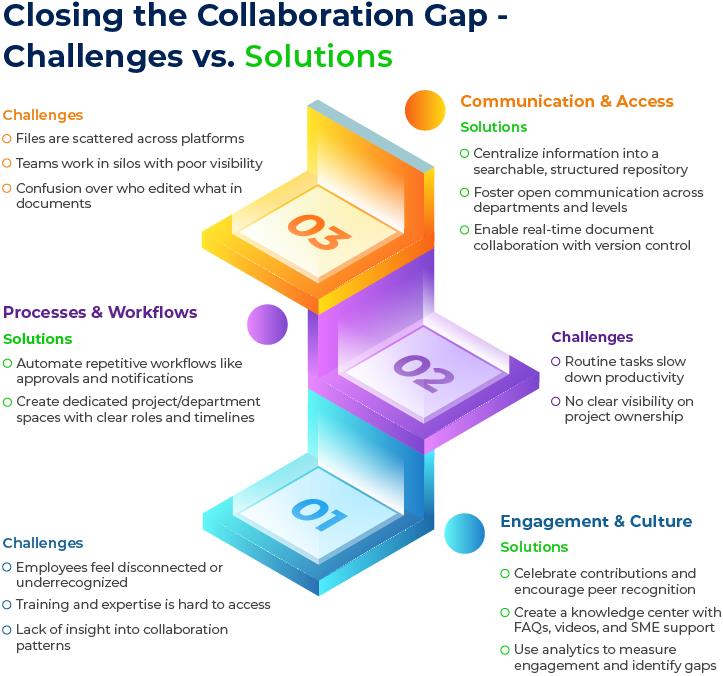Table of Contents
- Centralizing the information
- Encourage document sharing and document collaboration
- Fostering a culture of open communication
- Automate routine workflows
- Encourage recognition and team engagement
- Leveraging customizable project and departmental space
- Create a dedicated knowledge center or training portal
- Measuring engagement using analytics
- Investing in the right workplace collaboration tool
- BizPortal 365: Helping modern organizations improve their workplace collaboration
Step into a smarter digital workplace
Get a Free Product TourSummary
Are you finding it challenging to improve collaboration at work? This blog explores 9 essential strategies that can transform the way your teams communicate and collaborate. From centralizing information to automating workflows, you’ll discover how to make collaboration more efficient and engaging. If you’re unsure about which digital tools to choose for better workplace collaboration, don’t worry—there’s a bonus waiting for you at the end of the blog to help guide your decision-making process.
With rapid globalization and increasingly distributed teams, learning how to improve collaboration in the workplace has become a key factor in amplifying organizational success.
What do you think of workplace collaboration?
Workplace collaboration is when people in an organization work together to achieve broader organizational objectives more efficiently.
Well, if you are thinking of just meetings, connections, and clear goals. You may be wrong.
It’s more about internal communication, information sharing, collaborative tools, and leveraging each individual’s capability to come up with more effective, innovative, and timely solutions every single time.
However, recent research by Fierce Inc. reveals that 86% of respondents believe poor collaboration is a significant contributor to workplace failures.
This is a considerable number highlighting the actual reality of organizations and their workplace collaboration strategies.
Amid the growing complexity of today’s changing workplace dynamics, challenges such as communication gaps across time zones, unclear goals, poorly defined roles and responsibilities, and inadequate tools continue to threaten even the most carefully crafted workplace collaboration strategies.
So, what are those strategies that can really transform the way teams collaborate?
Let’s explore.
1. Centralizing the information
You should try centralizing your documents, records, Excel sheets, forms, and other relevant materials. Evidently, with more and more organizations going global, employees and cross-functional teams find it challenging to search for information that is often siloed in departments or cluttered on network drives.
However, by centralizing information, your teams know exactly where to upload or find documents, allowing them to collaborate faster, thereby enhancing transparency and communication.
You can create dedicated document libraries based on projects or departments, add relevant metadata, or simply add a universal search option to further ensure your documents are organized and accessible on time.
2. Encourage document sharing and document collaboration
Like information accessibility, information sharing also plays a critical role in improving workplace collaboration.
When employees can easily share documents and collaborate on them in real time, it helps them stay aligned, allows them to contribute effectively, and offers clarity on who made specific changes and when.
Creating channels to easily share documents and leveraging adequate document collaboration features, such as version history, co-authoring, and more, can reinvent your workplace collaboration strategy.
You can empower them with permission-based access controls to set either edit, view, or review permissions for others while sharing documents, making the information more secure than before.
However, in a SharePoint environment, you can always roll back to the previous version in case of undesirable changes or mistakes, allowing employees to work on the same document without worrying about overwriting each other’s work.
3. Fostering a culture of open communication
Open communication is not restricted to regular communication between colleagues. Instead, it is about the actual flow of information across the organization that breaks down silos, ensures clarity, and improves workplace collaboration. Well, here, information includes documents, ideas, opinions, objectives, news, and more.
Certainly, ensuring two-way internal communication—among employees and between employees and management—is essential to setting a clear tone for open and uninterrupted communication.
While you can create different teams, departments, and project sites for better communication, you can also utilize discussion groups, automated emails and reminders, and shared calendars to enhance peer-to-peer communication.
When it comes to employee–management communication, having a dedicated section for news and announcements, conducting regular feedback sessions, polls, or surveys, and sharing blogs that highlight organizational objectives, policies, and vision can go a long way in keeping both leadership and employees aligned and informed.
4. Automate routine workflows
Automating standard, repetitive, and time-consuming tasks brings two significant changes. First, it reduces human errors and delays, and second, it saves significant time for employees to actually brainstorm, discuss, and collaborate meaningfully on tasks.
You can start by creating automated workflows that trigger alerts, reminders, and notifications based on specific actions. For instance, an email notification is automatically sent to the employee concerned when a document is uploaded, a task is completed, or approval is pending.
Similarly, you can automate task assignments, progress tracking, reviews and approvals, employee onboarding process, issue tracking, employee training, and more to further streamline business processes and facilitate timely communication, enhancing overall productivity.
5. Encourage recognition and team engagement
When employees know each other and are recognized for their efforts and contributions, they feel motivated. It builds trust and fosters a sense of belongingness, which further encourages a culture of teamwork and mutual support.
Surprisingly, as per Gensler’s latest Global Workplace Survey Comparison report, people spend 42% of time working with others and only 35% of time working alone, highlighting the importance of workplace collaboration and employee engagement even more than before.
However, simply following a few steps, like creating a space for employees to access their coworker’s professional details, celebrate their success or milestones, acknowledge their contributions, and wish them birthdays, can amplify your employee engagement efforts.
Also, allowing your employees to post blogs to showcase their expertise and simply react or comment on others’ posts to share their views can also make them feel involved and connected with the workplace.

6. Leveraging customizable project and departmental space
When each project or department has its own site, employees can quickly grasp the project’s details, goals, timelines, and resources, making it easy for them to understand their roles and collaborate toward achieving shared objectives.
A study by Fierce Inc. proves that 97% of people believe misalignment leads to poor project outcomes. Certainly, poor workplace communication, unclear objectives, and lack of visibility into available resources and deadlines are the primary causes of misalignment, and creating customizable projects and departmental sites can help.
Similar to SharePoint, you have the option to create different sites with customizable templates, where you can add and arrange various tools, such as document repositories, calendars, and counters.
Alternatively, you can simply add quick links to frequently used documents and standard forms or create a dashboard that provides a detailed summary for stakeholders.
Certainly, this helps offer in-depth insight into everything your employees will need to effectively collaborate, be productive, and make wiser decisions.
7. Create a dedicated knowledge center or training portal
Creating an organizational knowledge base offers employees access to shared expertise and ensures everyone is on the same page, making it easier for teams to work together, irrespective of their location or department.
A recent study by Gallup suggests that 84% of employees work in a ‘matrixed’ environment, working across multiple teams and reporting to different managers. Apparently, a knowledge center offering uninterrupted access to training videos, recorded presentations, process documentation, FAQs, manuals, and market research can serve the purpose of facilitating cross-functional collaboration.
Also, you can assign subject-matter experts to help employees with their questions and reduce the time spent searching for the information or waiting for email replies—this not only improves the response time but amplifies your overall knowledge management efforts.
8. Measuring engagement using analytics
Tracking and measuring metrics like content contribution, collaboration frequency, user participation, etc., offers in-depth insights into collaboration patterns like who collaborates, through which tools, and how often. Certainly, what you can measure is what you can improve.
It helps you identify collaboration gaps, recognize patterns, spot high-preforming individuals, and enable data-driven decision-making.
SharePoint, being a centralized and customizable solution, is often preferred by organizations for two reasons. First, it is a centralized platform offering clear highlights on data across the organization, and second, you can always customize it according to the trends you are observing.
A few of the most common metrics that you can track to improve workplace collaboration are listed below:
- Document co-authoring rate
- Access logs to shared resources
- Likes, comments, and feedback on posts
- Page views per user
- Survey response rates
- Involvement in discussion forums
- Task completion rate
- Active users on the portal or any specific tool
9. Investing in the right workplace collaboration tool
The right tool centralizes everything, empowers you to streamline and automate redundant and time-consuming tasks, offers real-time insights, and promotes cross-functional collaboration, making it even more important to choose wisely.
How to choose the right tool to improve workplace collaboration? Here is a list of benchmarks or features that can help:
- Offers social features like blogs, feeds, and polls
- Has robust document management and version control features
- Supports customization of layout, branding, and user access
- Easy-to-use interface to ensure employee adoption
- Includes built-in chat, comments, and discussion threads
- Seamlessly integrates with Microsoft 365 and third-party applications
- Allows creation of team spaces for focused collaboration
BizPortal 365: Helping modern organizations improve their workplace collaboration
For modern organizations, workplace collaboration has been a primary factor in improving productivity, enhancing employee efficiency, and ensuring long-term success.
BizPortals 365, a SharePoint-based intranet, is a promising platform to bridge the gaps between your employees, teams, and departments.
From seamless document sharing and co-authoring to automating standard workflows and creating dedicated sites, it helps you amplify your enterprise collaboration efforts.
While it allows your employees to connect, discuss, and share opinions with their coworkers, it fosters real engagement where they can celebrate each other’s contributions, birthdays, and milestones—all in one place.
Yes, you can always keep track of analytics, analyze trends, assess engagement levels, and customize the platform that truly aligns with your workplace collaboration goals.
Want to see how the powerful features of BizPortals 365 can help improve your workplace collaboration? Book a live session with our experts and get a personalized walkthrough.
Table of Contents
- Centralizing the information
- Encourage document sharing and document collaboration
- Fostering a culture of open communication
- Automate routine workflows
- Encourage recognition and team engagement
- Leveraging customizable project and departmental space
- Create a dedicated knowledge center or training portal
- Measuring engagement using analytics
- Investing in the right workplace collaboration tool
- BizPortal 365: Helping modern organizations improve their workplace collaboration
Step into a smarter digital workplace
Get a Free Product Tour

